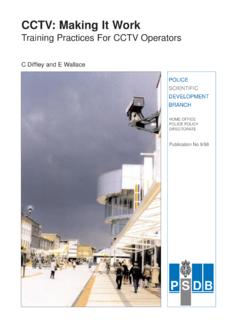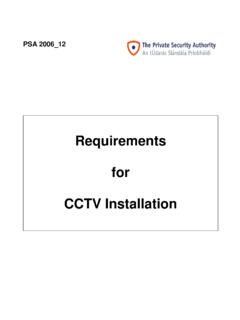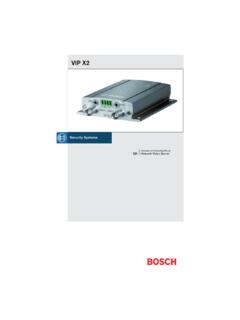Transcription of 55-06 - CCTV Operational Requirements Manual - Global MSC
1 Publication No. 55/06N CohenJ GattusoK MacLennan-BrownCCTV Operational Requirements ManualIs your cctv system fit for purpose?55/06iCCTV Operational Requirements ManualVersion CohenJay GattusoKen MacLennan-Brown55/06ii55/06 cctv Operational Requirements ManualVersion CohenJay GattusoKen MacLennan-BrownPublication No. 55/06 FIRST PUBLISHED JANUARY 2007 CROWN COPYRIGHT 2007 Home Office Scientific Development BranchSandridgeSt. AlbansAL4 9 HQUnited KingdomTelephone: +44 (0)1727 865051 Fax: +44 (0)1727 816233E-mail: 1 Operational 1 OR 2 Operational 2 OR Checklist for the of View (FoV).. Light Level 36 Appendix A:Example Completed Site B:Blank OR use of cctv has become increasingly widespread throughout the UK over recent years. Originally deployed for protecting large establishments and monitoring city centres, cctv systems are now installed routinely within shops, schools, and even individual vehicles on the public transport network.
2 Additionally, the market has undergone a rapid transition from analogue to digital recording technology, which has had a significant impact on the design and functionality of cctv developments mean that an update is now required to the original cctv Operational Requirements Manual , published by HOSDB (then PSDB) in focus of the document remains the same: to provide clear guidance to non-technical users wishing to buy a cctv system that is fit for purpose. However, the new Manual considers the additional issues of recorded image quality and data archiving that are essential parts of any digital cctv system, but are often neglected when writing the cctv recording systems were relatively simple to design as they relied mainly on the use of VHS tapes to capture the images. Digital recording systems, by contrast, are much more complex to specify. They record onto a hard drive, which can only store a limited amount of video; when it is full the oldest material will be overwritten with new.
3 Therefore when specifying a system thought must be given to the capacity of the hard drive, the provision of a suitable method to create a permanent record of any key incidents ( DVD writer) and the use of compression (which will affect the recorded image quality). Many of these issues are inter-related; thus improved recorded picture quality and higher frame rate may come at the expense of a reduced retention time on the system. One of the key aims of this publication is to provide some guidance on these complex is ongoing at HOSDB to investigate these issues in more detail and also to devise a means of assessing the image quality of digitally recorded cctv . The results of this research will be published in future updates of this are four key stages when planning the installation of a cctv system, summarised in figure 1. The first step is to define the problem, be it a security threat, public safety issue or other vulnerability. This is known as the Level 1operational requirement (OR).
4 Consider at this point whether the installation of a cctv system is the most appropriate response to these concerns, or if there are alternative developed a clear picture of the concerns that need to be addressed, attention can be turned to the specific issues relating to the cctv system itself. This is known as the Level 2 Operational requirement. Development of a level 2 OR helps the cctv user/manager to: Further define the areas of concern Understand Operational issues and responses Decide on the most suitable system Requirements Identify any managerial implicationsAn OR checklist is provided in section 4 to guide the cctv user through these issues and provide a structured series of questions to answer, that will ultimately form a clear Operational requirement that can be passed to a manufacturer or third step is where a more detailed technical specification for the cctv system is developed. Further information on the system design is provided in section 5.
5 For example there is information on camera selection, the effects ofcompression on image quality, and guidance on how to estimate the storage capacity that should be included with the final stage in the process occurs when the system is installed and commissioned. At this point it is important to check that it meets the Operational Requirements and that the performance is fit for 1: Key stages in specifying a cctv system 55/0653 Level 1 Operational focusing on the requirement for the cctv system itself, some thought should be given to the nature of the problem or threat that needs to be resolved. This high-level statement of the overall security need is known as the Level 1 Operational Requirement. A simple Level 1 OR checklist is shown in figure 2, and is accompanied by a set of explanatory notes. Completion of a Level 1 OR checklist should help to ensure that the strategic issues are analysed first and that the most appropriate solution is arrived at, even if this requires options other than cctv to be 2: Level 1 OR checklist 1 OR ChecklistSite planThe first task when constructing an OR is to draw a site plan on which to mark the areas of concern.
6 The more detail that can be included in this plan the better as this will aid in the placing of lights and cameras especially with regard to fields of view and potential environmental problems such as low sun or foliage. An example site plan is shown in figure 3, for large commercial premises with an attached car 3: Example site plan with threats marked NCCCC aaaarrrrPPPP aaaarrrrkkkk::::----tttthhhheeeefffftttt ,,,,aaaassssssssaaaauuuulllltttt,,,,dddd aaaammmmaaaaggggeeeeFFFF rrrroooonnnnttttDDDD oooooooorrrr::::----IIII ddddeeeennnnttttiiiiffffiiiiccccaaaatttt iiiioooonnnnTTTT iiiillllllllssss::::----tttthhhheeeeffff tttt,,,,aaaassssssssaaaauuuulllltttt,,,, ffffrrrraaaauuuudddd,,,,qqqquuuueeeeuuuu iiiinnnnggggSSSS hhhheeeellllvvvveeeessss::::----tttthhhh eeeeffffttttSSSS ttttoooocccckkkkrrrroooooooommmm::::---- tttthhhheeeeffffttttBBBB aaaacccckkkkDDDD oooooooorrrr::::----bbbbrrrreeeeaaaakkkk ----iiiinnnn,,,,ddddeeeelllliiiivvvveeee rrrryyyy55/067 Statement of problemWhat are the problems / threats/ security issues to be resolved?
7 The next step is to define the problems that affect the site. Some of these may be general threats but some may be specific to a given location. Typical threats or risks that might be identified include: Crowd control Theft Unauthorised entry Public safetyThese potential problems and/or threats can be marked on the site plan. This can then be used to visualise the scale of the problem and the level of cover required. Some areas such as checkouts and entrances/exits may need cover for different activities to monitor flow of people and to identify people in the event of a theft or are the stakeholders?If the installation is likely to be complex and involve several different stakeholders, then they should all be consulted at this stage in the process and asked to identify their Requirements on the site AssessmentWhat is the realistic likelihood of the activity happening? Low / medium / highWhat would be the consequences if the activity was not monitored and/or recorded?
8 Minor / moderate / severe For example, will the activity result in financial loss or compromise the safety of your personnel or the public?Can you prioritise the activities you wish to monitor?Could you use alternative (or more cost-effective) methods to tackle the ac tivity such as better lighting, fences or intruder alarms?Is the activity likely to be a short or long term issue?Success CriteriaAfter detecting an activity, what is a successful outcome? Prevention of theft of damage Id entification of intruder2345855/06 Improvement in traffic flow at the checkout Deterring an activityThe success will be determined by a combination of how effectively the system performs and how well it meets the Operational often will you expect a successful outcome?( How effectively / reliably will the task have to be done?) All of the time On most occasions Always during the day, but only occasionally after hoursDetermine the most effective solutionOnce the problem areas and potential threats have been marked on the plan, then an assessment can be made of the most effective solutions.
9 cctv is likely to be only one of a range of possible options and should be considered in the context of a wider security/safety audit, alongside other measures such as: Lighting Physical protection / barriers Proximity alarms / intruder detection systems Improved site design / threat removalThere are, however, several scenarios where a correctly designed cctv system may be of benefit. These usually fall into one of three broad categories: Safety / security Deterrence Crime investigationOf these, it is often the requirement for post event crime investigation that is not given adequate consideration at the point when the cctv system is designed and specified. This may only become apparent at a later time, when for instance the video is required for a police investigation. It may then be discovered that the recorded images are of a poor quality and not fit for purpose. Another common failing is that inadequate facilities are provided for the replay, archiving and sharing of the recordings.
10 Awareness of these issues is of particular importance following the widespread transition from analogue to digital recording a decision has been made to install a cctv system, a full Level 2 Operational requirement should be developed, as described in the next 2 Operational purpose of this section is to provide a guide through the process from the decision I need cctv to the commissioning of an effective system. The first and most important question to be addressed with any cctv system is What do I need to see? closely followed by Why do I need to see it? Most camera systems are designed to observe human activity. The application, however, can range from crowd control / public safety (where the movement of large numbers of people needs to be monitored over a wide area) to access control (where close-up, high quality imagery is required to enable individuals to be identified). The choice of cctv camera in particular will depend on the nature of the activity to be simplify the situation and provide guidance to a system specifier, four general observation categories have been defined, which are based on the relative size that a person appears on screen (figure 4).









